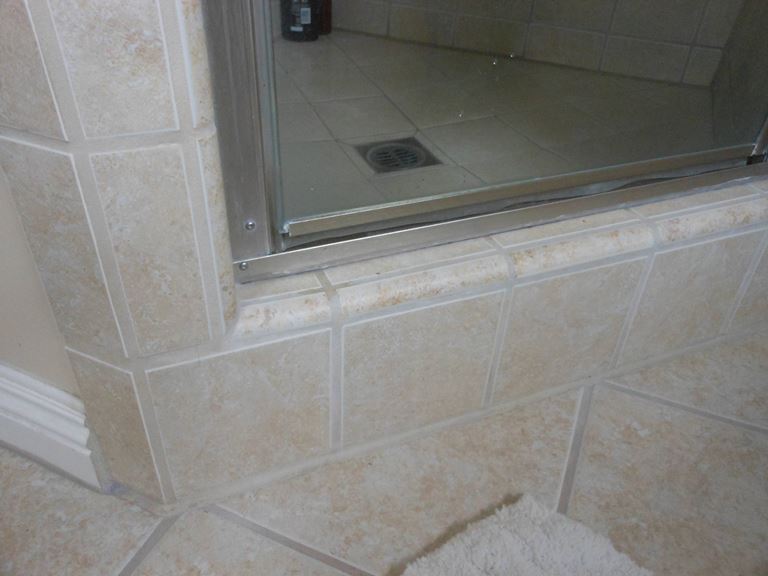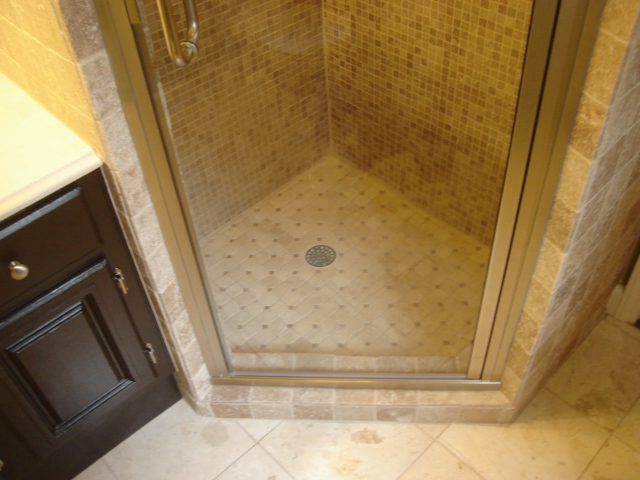
Do not force something solid or substantial, such as a shampoo bottle cap or part from a child’s toy, further into the drain with a hasty use of the plunger. Objects such as these should be extracted before they get beyond reach. Also consider if the problem in the shower is not a symptom of a larger issue. Shower and floor drains are among the first to show signs when there is blockage in the wastewater and sewage drains from the house to the main. This page discusses how to clear a clog in the drain of the shower, if you suspect a sewer backup, and are experiencing slow or intermittent drainage throughout the house, you will want to call your local utility company.
Most shower drain clogs can be cleared without having to remove any straining plates in place over the drain, but do remove any strainer or stopper parts that can easily come away. If you do feel the need to remove the strainer, take care not to drop any screws down the drain and have a receptacle prepared to keep all small parts safely out of the way. Instead of a simple strainer, your shower may have a canister shaped gas-trap directly beneath the drain, but the procedure for cleaning then plunging still applies.

Liquid drain cleaners are hazardous. If liquid drain cleaner has already been applied, you must exercise extreme caution going forward--including wearing gloves and eye protection--until you have cleared the clog and rinsed the pipes and shower thoroughly of this dangerous chemical, and make sure anyone else working near the area is aware of the danger.
However, a little softening can be helpful in breaking up large or dense clogs. We recommend letting the clog soak in a mixture of grease busting dish-soap and hot water. If your shower has standing water refusing to drain, squirt some soap directly down the hole, next pour hot water from a height into the drain. The hotter the water the better, but be smart and do not use water so hot that a splash would burn your skin, and do not pour water into a mixture containing liquid drain cleaner! Let the soap soften up the clog for a few hours if you can. If the clog has not drained away, you can move on to the next suggestions.
If the blockage is near-complete, and you have standing water in the shower, assuming you have not dropped a golf ball down the pipe, going next to either the plunger or drain auger cable is advised.
On the other hand, if you can peer into the drain with a flashlight, and can see the obstruction or have an idea of its location, then your first priority should be to remove all the debris from the drainpipe. A wire coat hanger, bent to take advantage of the squiggle into a hair-snagging hook could be all you need, along with some patience, to extract the mass forming the clog.
Even in the case of standing water, you can safely stick your bent hanger down the drain, and scrape the sides as you go, rapidly busting up anything in reach. Always opt to remove the gunk with gloved hands to toss in the trash, rather than trying to rinse it down the drain and possibly out of reach.
Any clog that survives the coat hanger treatment will surely be weakened and ready to fall to the plunger. Your goal with the plunger is again to break up the clog, removing as much of the debris as possible from the drain, and finishing with pipes flowing as smoothly as ever.
With that in mind, if your clog has been softened with a soaking in dish soap and weakened with pokes by your hanger, or even if the blockage is out of reach, you next step is to try the plunger.
The most important aspect is a tight seal so the plunger exerts the strongest possible pushing and pulling effect on the clog.
A plunger must have some water to work with so if there is none standing in the pipe, run some water before trying to plunge away the clog. Placing the plunger over the hole of the drain, form and maintain a tight seal as you vigorously work the plunger up and down for up to a dozen strokes before checking. Release the seal carefully to avoid backsplash. If you have trouble maintaining a tight seal you can apply a small amount of petroleum jelly around the lip of the plunger and drain (not too much!) to plug the gaps.
TIP: If you find the plastic or rubber of your plunger to be too stiff, run it under hot tap water in a sink to loosen the action a bit and reduce the amount of required effort.
If you have done all the above, and find your shower is still draining slowly or not at all, you should consider consulting with a professional. It is possible you have misdiagnosed where the problem lies, and a professional plumber or drain cleaning service could take over before things get out of hand.
That being said, if you own a handheld or electric drain auger (also known as a Plumber’s Snake), then it may be just the ticket. A drain auger is a long, stiff cable which can be threaded into plumbing to bore a clear path. A good auger can be worth its weight when it comes to cutting down on calls to the plumber for active or large households.
Once you have fixed this problem, be sure to take preventative measures to avoid it in the future. It is critical that shower drains have some sort of strainer in place to prevent bottle caps, toy parts, and soap slivers from falling into the drain, but you don’t have to catch every hair. Be responsible, and equip all floor drains, such as those in basements and pool areas, with maintained backflow-prevention devices to minimize risk of flooding and irreparable damage to property.
 Enzytabs Septic Tank System TreatmentHELPS PREVENT SEPTIC BACKUPS: Effectively degrading grease. REDUCES BAD ODORS: Continuously breaking down the odorous volatile fatty acids.
Enzytabs Septic Tank System TreatmentHELPS PREVENT SEPTIC BACKUPS: Effectively degrading grease. REDUCES BAD ODORS: Continuously breaking down the odorous volatile fatty acids.
 PermaFLOW Never-Clog DrainNever hassle with the tassle again.
PermaFLOW Never-Clog DrainNever hassle with the tassle again.
 TEKTON 36-Inch Claw Pick-Up Tool36 in. flexible spring steel shaft. Spring-loaded, 4-prong steel claw. Retrieves small, non-ferrous objects that magnets cannot
TEKTON 36-Inch Claw Pick-Up Tool36 in. flexible spring steel shaft. Spring-loaded, 4-prong steel claw. Retrieves small, non-ferrous objects that magnets cannot
When you have a toilet plunger, you are well prepared for clearing clogs made up of anything softer than a rubber ducky.
UncloggingDrains101.comWhich Household Drain Problems Can Be Handled Without Calling A Pro?
UncloggingDrains101.comTips, hints, and full instuctions for unclogging your bathtub drain, and restoring fast, free flow
UncloggingDrains101.comLearn how to quickly and easily clear your stopped up laundry sink or utility basin
UncloggingDrains101.com Black & Decker The Complete Guide to PlumbingYou might not have to call a plumber; get the most comprehensive, up-to-date book on home plumbing for DIYers of all skill levels instead
Black & Decker The Complete Guide to PlumbingYou might not have to call a plumber; get the most comprehensive, up-to-date book on home plumbing for DIYers of all skill levels instead
 FlexiSnake Drain Millipede Hair Clog ToolOur toughest hook & loop hair-clog tool. Reusable & works with most bathroom drains without disassembling the stopper
FlexiSnake Drain Millipede Hair Clog ToolOur toughest hook & loop hair-clog tool. Reusable & works with most bathroom drains without disassembling the stopper
Step-by-step instructions for making quick work of clogged or slowly flowing bathroom sink drains
UncloggingDrains101.comEverything about unclogging floor drains, from the toughest job to the quickest maintenance
UncloggingDrains101.comWhen clogs form in bathroom sinks, showers, bathtubs, kitchen & utility sinks, or shop & laundry drains—then the preferred tool will be a drain auger.
UncloggingDrains101.com